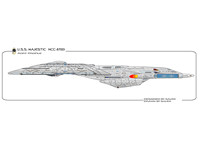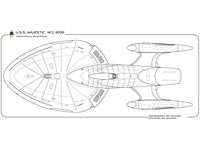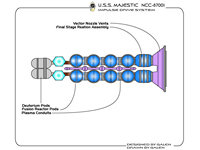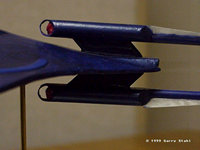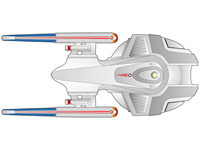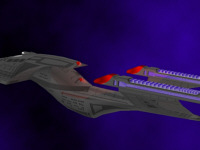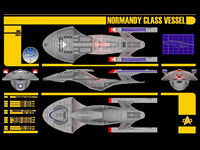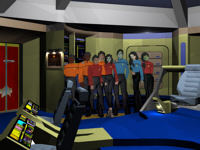Starships M-N
Starships, Starships A-B, C-E, F-H, I-L, M-N, O-Q, R-S, T-Z, Space Stations
M'Kallya Class
Design by Gustavo Castillo
Type: Cruiser
First commissioned: 57011.3
Length: 302m
Width: 152.7m
Height: 54.5m
Decks: 13
Complement: 46 officers + 117 crew, evacuation limit: 5000
Speed: Warp 8 (cruise), Warp 9.5 (max.), Warp 9.85 (max. emergency)
Sublight speed: 0.56c (max.)
Armament: 17 standard stripe phaser banks, two frontal phaser pulse cannons and fore and aft torpedo launchers
Defense: Metephasic shielding, level 5, combined with ablative armor
Embarked craft: 5 type 22 shuttlecrafts, 1 type 31 cargo shuttle,6 type 18 shuttlepods, 5 workbees
During the Dominion War the number of Excelsior class starships decreased close to the verge of extinction. Soon after, the few remaining were destined to serve as museums and school ships, to preserve the last exponents of a proud and glorious, not to mention legendary, lineage.
The problem was that these versatile and fast vessels were often the starships of choice for transporting Admirals throughout Federation space. Admiral Volek took upon himself the task of finding a suitable transportation for the highest ranks of Starfleet. He found the explorers being too big and the escorts too slow and so on and so forth. Finally, after a fruitless search, it was decided that the logical course of action was to design ship dedicated to serve as an Admiral's vehicle. A graduate from the Vulcan Academy of Science and an expert in warp propulsion systems, admiral Volek led the most selected team of engineers that the Advanced Starship Design Bureau had to offer.
The team focus was mainly in achieving two goals:
- Provide a proper scenario for diplomatic and military missions.
- Be an effective warship so the Admiral can assume command of the fleet in times of armed conflict.
This was not to be an exploration ship, nor a families transport. And it will only have the necessary amount of laboratories needed to ensure its functionality.
The prototype, the U.S.S. M'Kallya, is a 13 deck, 302 meters long starship, whose design can be instantly related to that of the Hannibal and Akira classes. Its warp capability reaches a top speed of Warp 9.85 and has great maneuverability at sublight ranges. She has all the necessary comfort, services and commodities to accommodate dignitaries from every possible culture imaginable. Even a luxury or two. There are two large halls, one for conferences and the other for receptions and banquets. They can both be turned into war rooms if the situation calls for it.
The number of guests rises up to 200 plus entourage. A permanent crew of 160 people take care of the systems of the starship.
She has teeth as well, 17 standard stripe phaser banks, two frontal phaser pulse cannons and fore and aft torpedo launchers. Metaphasic shielding, level 5, combined with ablative armor, deflects even a Breen energy dissipator pulse.
Two innovations set the M'kallya apart from the rest:
- Double coiled warp engines
- Main deflector and sensor composed by four groups of elements disposed in an horizontal angular configuration
The double coiling, Volek's creation, does not provide a larger warp speed than the single one, but it optimizes the usage of plasma, needing 15% less amount of matter-antimatter fuel to achieve the same speed. An unintended side effect is that the resulting warp stream is 25% more friendly to the fabric of space, causing reduced damage at 5+ warp.
The disposition of the deflector provides a broadened coverage angle and minimizes the use of space on the Z axis of the ship. It is also not as bulky on the Y axis allowing for a narrower, sleeker profile. The sensor readings, being redundantly scanned four times over, proved to be more accurate and each of the four groups can be pointed at different directions for an even wider coverage.
M'Kallya is ths name of the 3rd city in importance in Vulcan. It is also the birthplace of Admiral Volek, but that isn't the reason why he picked that name, of course. We all know that Vulcans are not sentimental people.
To avoid conflict in the chain of command, there's no appointed Captain on board the M'Kallya, being the admiral who covers that position during important missions. For standard operations is the second in command, Cdr. Sophia Mirkos, who acts as Captain. It was the Admiral's attaché, his adoptive daughter Lt. Commander Rhyanu, an orphan half Klingon, half Romulan left behind after the Romulan attack at Khitomer, who selected her for that position, knowing the preferences and needs of the Admiral. (It has been said that Rhyanu is the closest that will ever be to a logical Klingon).
Thanks to Bernd Schneider, creator of the Hannibal class.
Magneto Class
Design by Luke D'Anvil
Type: Light patrol vessel
First commissioned: 2383
Length: 130m
Width: 100m
Height: 32m
Decks: 7
Displacement: 390000t
Complement: 10 officers + 20 crew, evacuation limit: 80
Speed: Warp 8.3 (cruise), Warp 8.7 (max.), Warp 9.65 (max. emergency)
The Magneto is the first of 29 planned small border patrol vessels, which are supposed to guarantee a flexible survey of the outside sectors. At least the prototype works fine as replacement for the Saber class: On a routine flight the crew discovered a large comet on course to the homeworld of the Tellarites.
Majestic Class
Design by Malcolm Lu
USS Majestic NX-87001
Type: Deep-range explorer
Commissioned: 14th August 2379
Length: 580m
Width: 206m
Height: 88m
Deck count: 25
Displacement: 3,450,000mt
Crew complement: 800
Maximum crew capacity: 5000Cruising velocity: Warp 7.2
Maximum velocity: Warp 9.985 for 12 hrs
Sublight Cruising Speed: 0.35c
Max. sublight speed: 0.60c
Maneuverability: averagePropulsion systems: Warp: 2 LF-49 Advanced Linear Warp Drive units
Impulse: 2 FIG-6 Subatomic Unified Energy Impulse unitsPrimary computer system: M-16 Bio Neural Gelpack Isolinear III Processor
Primary navigation system: RAV/ISHAK Mod 3 Warp Celestial Guidance
Deflector systems: FSS-3 Primary Force Field and Deflector Control System
Weapons: 12 Type-XII phaser arrays, 4 Mk-95 direct fire torpedo launchersDefense systems: regenerative shielding, hull armour plating
Embarked craft:
4 Work Bee General Utility Craft
4 Type- 11 shuttlecrafts
4 Type-9 shuttlepods
1 executive shuttle (Suricata)
1 captain's yacht "Celestar"
Other ships
- USS Titan NCC-67101-A - standard sensors
- USS Ascendant NCC-87002 - Federation courier vessel
- USS Southern Cross NCC-87004
- USS Illustrious NCC-87005
- USS Regal NCC-87009
- USS Caelum NCC-87013
- USS Avior NCC-87018
- USS Leviticus NCC-87022
- USS Aquila NCC-87025
- USS Perseus NCC-87027
- USS Orion NCC-87035 - enhanced sensors
Mission
The primary mission of the Majestic-class explorer is to serve as the preferred starship platform for diplomatic and exploration missions for Starfleet Command's Deep Space/Long-Range Exploration program, approved in fiscal year (FY) 2375, and the Gamma Quadrant Exploration and Diplomatic Improvement Initiative, approved in FY 2377. The secondary mission of this starship class is to serve as a heavy-combat capable, robust and resilient, fast moving, and hard-striking weapons platform for small border skirmishes and police actions on up through large fleet actions and engagements during times of war. A diplomatic courier variant of the Majestic-class was created for diplomatic missions for the exclusive use of the Federation Council. Plus a variant of this class was created as a fleet command-and-control starship, painted with the Starfleet Command Blue color scheme, for Admiral William "Bill" Ross, commander of the Eighth Fleet, replacing the Intrepid-class U.S.S. Bellerophon NCC-74705 as his flagship.
Because of its size, between the Intrepid-class Light Explorer and the Sovereign-class Heavy Enhanced Deterrence Explorer, its capabilities, and relatively short four-year construction time, the Majestic-classis expected to serve as the backbone of Starfleet well into the 25th century, much like the retiring Excelsior-class served in this capacity during the late 23rd and 24th centuries. For these reasons, Starfleet Command has placed an initial order of 32 vessels of the Majestic-class. Expert Starfleet watchers and civilian experts expect that the numbers of the Majestic-class vessels to be in service will reach in the hundreds during its 80-year service life, and there is no doubt it will lead Starfleet's newest initiatives in the 25th century.
Features
The Majestic-class follows the design philosophy of recently introduced starship classes, such as the Intrepid-class. The ship features no connecting dorsal strut between the primary and secondary hull. Instead, both sections are blended together to reduce vulnerability from attack and decrease target-able profile, decrease drag and improve performance at warp speeds, and increase the structural integrity of the ship. To facilitate the ship's ability to travel in deep space, this class is equipped with the fast and reliable LF-49 Advanced Linear Warp Drive, giving the class a standard cruise velocity of Warp factor 7.5 and a twelve-hour dash-warp emergency velocity of Warp factor 9.985.
Enhancing the class' capabilities navigation and star-mapping capabilities is its new Model XYZ (RAV/ISHAK Mod 4 Warp Celestial Guidance) advanced sensor, navigation, and astrometrics suite, which utilizes Borg-derived technology. The Majestic-class is the first starship class to be fully outfitted with this new mapping and stellar navigation technology, replacing standard stellar cartography. The technology used in this system were acquired when the U.S.S. Voyager NCC-74656 returned to Earth in 2377 after her seven-year journey in the Delta Quadrant. Astrometrics sensors are at least 100% more efficient and effective compared to Stellar Cartography sensors, which greatly increase the efficiency of the ship's exploration missions over earlier starship classes. Specific details about this system are still classified by order of Starfleet Command.
In order to defend itself against hostile forces, the Majestic-class has been armed with thirteen Type XII-F Collimated Phaser Arrays and four Mk 95 Direct-Fire Torpedo/Probe Launch System tubes, capable of firing all models of quantum and photon torpedoes currently in Starfleet service. This launch system is also capable of launching all science/sensor probes and buoys currently in service with Starfleet as well.
The shield generators on this class are considered to be some of the strongest in the fleet, capable of both regenerative and multi-phasic modes. The last addition to the ship's defensive systems is the introduction of "crystalline armor" on key areas of the ship. This armor is based on the "deployable" armor brought back by U.S.S. Voyager. As the research and development teams at Starfleet Tactical are still unable to fully replicate this technology, a simpler version of this concept was created. This armor is fixed, non-deployable, and weaker than the original version. Its design utilizes tightly packed crystals to absorb and disperse enemy fire throughout the hull. After testing, this armor had been found to be stronger and lighter than the ablative hull armor currently in use on the Defiant-class escort. However, this armor only proves effective against energy weapons such as phasers and disruptors. Projectile weapons could have a higher chance of piercing through the armor, but it would provide sufficient protection for one or two hits.
Background
During the Dominion War, the Advanced Starship Design Bureau, Starfleet Tactical, and design and construction teams at shipyards throughout the Federation concentrated on designing and constructing new starships for the war effort. Consequently, the construction of new explorers was significantly curtailed, or suspended, in favor of producing large numbers of Defiant, Akira, and other starship classes that could be used as warships. Also during this period, starships assigned to Exploration Command were re-assigned and used as front-line battleships or were pressed into service as scouts to provide battlefield intelligence and reconnaissance. When the war was over, Starfleet began to inventory and assess its total fleet strength. Statistics showed that the number of explorers and science ships lost during the war was double that other starship types.
In February of 2375, Galaxy Exploration Command transmitted a request for proposal to all design bureaus and fleet yards throughout the Federation for a new medium class explorer that could support upcoming exploration projects and missions. Exploration Command made this decision after it extensively inventoried and reviewed the suitability of the remaining Excelsior- and Ambassador-class explorers still operating in the fleet and the age and condition of their spaceframes. After reviewing the proposals transmitted back from the Advanced Starship Design Bureau and others, Exploration Command selected a proposal submitted by Antares Fleet Yards for a medium-sized explorer based on the experimental U.S.S. Hyperion NX-86997 project.
The U.S.S. Hyperion was constructed at Antares Fleet Yards to serve as an experimental systems evaluation prototype for a new class of heavy quantum torpedo cruisers or "battlecruisers." The goals of the Hyperion-class were to create a starship with the offensive firepower of the Achilles-class, combined with the speed, agility, and maneuverability of the Intrepid-class derived Yeager-class, in a medium-sized explorer platform. Like the Achilles-class, the Hyperion class was intended to attack and destroy heavily defended shipyards, Ketracel White factories, and Jem'Hadar hatcheries, but with greater range, greater time between fleet replenishment, and longer deployment schedules than the Achilles-class. With the end of the war in 2375, development of the Hyperion-class was cancelled and the prototype mothballed with the intention of using it as a future technologies test platform.
Antares Fleet Yards proposed to Exploration Command that the Hyperion-class prototype would be an excellent choice as the starting point for a new class of medium-sized explorers, and the U.S.S. Hyperion spaceframe was used to test and evaluate the Borg-derived technology that was ultimately deployed in the Majestic-class. The lead ship of this class, U.S.S. Majestic NCC-87001, is named in memory of the Miranda-class U.S.S. Majestic NCC-31060, which was lost with all hands during the battle to retake Deep Space Nine (Operation Return) in 2374. Use of the name Majestic also has along history and tradition in Starfleet and in the British Royal Navy, with many famous vessels bearing this name.
Mångsysslare Class
Design by Larry
Type: Modular cruiser
First commissioned: 2367
Length: 566m
Width: 270m
Height: 49m
Decks: 20
Displacement: 1087500t
Complement: officers + 246 crew
Speed: Warp 8 (cruise), Warp 9.4 (max.), Warp 9.8 (max. emergency)
Armament: 6x Type X phaser arrays, total output 25,000 terawatts / + 4,166 per phaser, 6x Type 3 burst fire photon torpedo tubes
Defense: Auto modulated shield system, total capacity 2,362,500 terajoules
This configuration is non-standard. The design is intended to always have a module or container attached. A bare minimum would be a recon cruiser configuration. Normally a battle, carrier, or explorer configuration is ideal. The containers seek to improve the usefulness without the expense of numerous custom designs. The same ship could be used to transport diplomats, the change containers to fulfill a colonization roll. Then change containers again to transport mass bulk or liquid supplies. The variations are customizable to suit as many rolls as possible.
Variants available: Bare, bare-fast, battle, battle-fast, carrier, carrier-fast, carrier-heavy, carrier-super, recon, explorer, explorer-fast, transport, transport-fast, transport-heavy, strike, strike fast, strike-light, scout, colony, colony-heavy, and colony-light.
Modules must be balanced. Single center line or matched on wings. Battle, Carrier, Explorer, and Scout modules cannot be placed in wings. Single Engines nor Scout and Weapon wing modules cannot be placed on centerline connector. A Light Carrier variant could be 3 Hangar-S modules, one centerline and one on each wing.
Thanks to all those who put their ideas on the web for kit-bashing.
Manta Class
Design by Phoenix
Type: Battlecruiser
Length: 1,230 feet (total), 985.5 feet (hull)
Beam: 1200 feet
Draft: 306.5 feet (total), 201.5 feet (hull)
15 decks
Manta class ships are pure battle cruisers. They have two primary functions. First, is home defense. Mantas and similar types will be found patrolling the Federation borders as a primary defensive line against possible aggression. The presence of a Manta on your border means that your threat is taken seriously, and will be met with all due force. The second function is as an offensive threat, to seek and destroy an active enemy.
Two Manta class ships were available during the late Cardassian war. They saw action on two occasions. As a result of these encounters the Cardassian High Command issued orders that the Mantas were not to be engaged at less than 5 to 1 tonnage odds. Peace was declared shortly thereafter, and the effectiveness of the tactical orders was not tested.
There are currently eight Manta class ships commissioned, and two under construction. No Manta class ships have been decommissioned or destroyed.
- CB 1 Diligent
- CB 2 Wanderer
- CB 3 Searcher
- CB 4 Inquisitive
- CB 5 Questing
- CB 6 Indefatigable
- CB 7 Rolling Stone
- CB 8 Ardent
3D model by Randall, who likes to thank Phoenix for his great inspiration.
Mapuche Class
Design by Gustavo Castillo
Type: Heavily armed explorer
First commissioned: Stardate 51007.2
Length: 467.5m
Width: 365m
Height: 112.5m
Decks: 18
Complement: 176 officers + 393 crew, evacuation limit: 6000
Speed: Warp 7.8 (cruise), Warp 9.2 (max.), Warp 9.76 (max. emergency)
Sublight speed: 0.65c (max.)
Armament: 13 standard phaser banks, 2 phaser pulse cannons, 4 torpedo launchers
Defense: Extra high dispersion metaphasic deflector shields, cocoon type
Embarked craft: 10 Type-22 shuttlecraft, 4 Type-31 shuttlecraft (inc. 1 Med-Away), 1 Danube-class runabout, 6 Type-18 shuttlepods, 6 workpods
Starfleet is, primarily, an organization dedicated to peaceful exploration. But there are times when that peace is threatened by cultures that don't share the same vision the U.F.P. has. Such a case are the Borg, the Dominion, the Romulans and many others. In those times is a good idea to have a weapon capable of defense and retaliation as the Defiant class starships. But in times of peace there is little use for such extraordinary arsenal other than patrolling the perimeter of the Federation space. There had to be a ship that can be useful in peace but also capable of warfare action.
Enter the Mapuche class starships. Named after a noble nation of natives from the Patagonia, the U.S.S. Mapuche was a vessel of great defensive/offensive capabilities: 2 phaser pulse cannons, a larger number of standard phaser banks, metaphasic shields, upper and lower front and aft torpedo launchers, and a amazing maneuverability for a ship its size due to a sleek and compact design and a very carefully placed gravitational center . But she also has room for research laboratories, fabrication complexes, recreation facilities, health and cultural centers. And she carries families onboard. Head designer Dr. August Castle took several features from the Miranda class and combined them with Sovereign technology, the result is a sleek, fast and powerful, yet comfortable starship. These features makes her a perfect tool for exploration, a bridge between civilizations and a more than efficient fighter when needed.
Unfortunately, like her namesake people, the U.S.S. Mapuche fell heroically in combat against a much numerous foe during the attack at the Chin'toka system, not before taken down 2 Jem'Hadar battle cruisers and 4 Breen. (Note: In times of open armed conflict the families and civilian personnel are taken to starbases or safe outposts, as standard Starfleet procedure.) Five other Mapuche class starships serve at Starfleet to this day: U.S.S. Firechild, U.S.S. Andalucía, U.S.S. Ironclad, U.S.S. Braveheart and the U.S.S. Stubborn, under command of Capt. N'Bate "Bats" Okode, which is the most decorated of the lot. On the U.S.S. Mapuche dedication plaque the motto was: "It is better to die on our feet, than to live forever on our knees."
On the U.S.S. Stubborn it is: "Preparation is the key to success."
Several elements designed for the Mapuche class such as the detachable Bridge module, the pyramid shaped thrusters, the Astrometrics dome, the captain's yacht etc., turn out to be so successful that they were incorporated as part of the features of other starships later devised, such as those of the
Arrogant and Adamant classes.
Marsh Marigold Class
Design by Luke D'Anvil
Type: Battle task ship
First commissioned: 2385
Length: 450m
Width: 400m
Height: 72m
Decks: 17
Displacement: 3400000t
Complement: 44 officers + 280 crew, evacuation limit: 520
Speed: Warp 9.3 (cruise), Warp 9.7 (max.), Warp 9.92 (max. emergency)
Commissioned as flagship for heavy assaults the Marsh Marigold class is still waiting for a decision about further production. In the moment the USS Marsh Marigold is involved in a field exercise with a squadron of the Romulan Empire.
Nebuchadnezzar Class
Design by Remko Wagemakers
Production base: ASDB Integration Facility, Juno Fleet Yards, Sector 001
Type: Advanced technology cruiser
Crew complement: 90 officers and crew
Power plant: one 2,000 plus warp core feeding two nacelles, two impulse systems
Length: 277m
Beam: 144m
Height: 60m
Mass: 550,000t
Speed: Warp 9.985 for 12 hours
Planetary landing capability
Development of the Nebuchadnezzar-class starship was originally begun in 2367, shortly after the first Borg attack on Sector 001. However, after the Prometheus-class Tactical Cruiser design was approved by Starfleet Command, the Nebuchadnezzar-class was put on hold. The nine spaceframes (SF) under construction where stored inside the Juno spacedocks, awaiting new technology breakthroughs. And were forgotten.
In 2377, USS Voyager returned from the Delta Quadrant. After the homecoming celebrations, the crew was debriefed and Voyager was transferred to Starbase Juno for analyses of the armor technology on her hull as well as downloading of the databanks. A massive amount of data was collected, and plans were made to incorporate it in a new class of starship. However, the Dominion war had drained Federation resources so badly that Starfleet would not approve a total new ship from scratch. Then, in 2382, Admiral Michael Kraven re-discovered the stored spaceframes of the Nebuchadnezzar-class. Since the ships only had their basic framework completed, they were ideal for integration of new technologies. Each of the ships would be custom built, and test different technologies. The pathfinder ship USS Nebuchadnezzar SF-01 was fitted with Voyagers armor, transphasic torpedoes and a stealth system designed from data which was found inside Voyagers databanks. The second ship, USS Wolverine SF-02 was fitted with Type-X+ planetary defence phaser banks and pulse phaser cannons. The other ships SF-3 to SF-07 were equipped with K-Layer subspace warp field synchronizers, transwarp-speed computer systems and other advanced technology. SF-08, which was still unnamed, is to be equipped with four torpedo launchers originally developed for the Defiant-pathfinder class starship (which became the Nova-class science ship). The last ship, USS Sentry (SF-09) is still under construction, but will be equipped with a Nebula like sensor pod. All ships had an upgraded version of the Class-9 warp core originally developed for the Defiant-class starship, giving them a maximum speed of warp 9.985 for twelve hours. To reduce costs, much of the shelf hardware was used. For example, the Nebuchadnezzar-class uses the same bridge-module and escape pods as the Defiant-class, although there systems have been upgraded to current technology standards.
Niagara Class
Design by Jason, ASDB Member
No specs available
The Niagara from the Fact Files being butt ugly, this would have been a very nice alternative in case the Fact Files ship had not been authentic.
Nighthawk Class
Design by Chris Edmonds
Type: Reconnaissance/explorer
Length: 332.48m
Beam: 275.12m
Draft: 63.88m
Mass: 1,880,000 metric tonnes
16 decks
Armament: 9 Type-12 phaser arrays (refitted from Type-11), 1 Class-VIa rapid-fire torpedo turret (fwd), 1 Class-V burst-fire torpedo launchers (aft), 180 quantum torpedoes, 4 transphasic torpedoes
Speed: Sublight acceleration 7,320 m/s^2; Warp 8 (std. cruise); Warp 9.7 (max. sustainable); Warp 9.99 (max. rated, 36 hours)
Crew: 23 officers, 237 enlisted, 1,250 evac.limit
The Nighthawk is an interesting specimen of what Starfleet's ASDB is capable of. It has several remarkable advances, namely in the fields of gaining sensor information, and not letting others see you gain this information. It carries the usual refinements that the Sovereign project and its Intrepid and Defiant project offshoots pioneered, such as ablative armor, advanced warp field geometry, quantum torpedoes, compact torpedo launchers, bioneural computer circuitry, etc.
During the Dominion War, Starfleet wished to strike deep within Dominion territory, to disrupt their logistical lines. However, due to their very comprehensive detection systems, the only way to remain undetected during the long journey was to hijack a Jem'Hadar ship, which proved very hard to do. Despite the constraints in the Treaty of Algeron, Starfleet R&D simply worked around the problem in making a stealth system for a Starfleet ship. In the end, the low-observability systems developed in the Nighthawk project paid off, though the prototype arrived too late for the Dominion War.
The Nighthawk class employs a remarkable two-layer system to avoid detection. First, it uses several special low-power chroniton field emitters, essentially "poor man's cloaking devices", to mask the ship from sensors. At a passing glance, a sensor scan would go right over it. In the event that they manage to arouse some attention, the second system is brought online: a silicon-based biological compound on the hull that mimics the surrounding colors and lights with remarkable accuracy. Coupled with its Eagle Eye augmented long range sensor array, the Nighthawk could see almost anything without being detected itself.
Though it never saw action in the Dominion War, it did see action extensively in the Sheliak War. By that time, the Nighthawk and her sister ships had been refitted with second-generation low-observability systems, and had their phaser arrays upgraded to Type-12 strength as well. They proved to be invaluable assets, as the Nighthawkand her sister ships often went marauding through the Sheliak logistical network, wreaking havoc with surprise attacks.
This starship is planned to feature in the fanfic Star Trek: Renaissance.
Nimrod Class
Design by Kris, ASDB Member
No specs available
No description
Niven Class
Design by Paul Lloyd
U.S.S. Niven NCC-63728
Type: Annular warp drive test bed
Developed 2379
Length: 210m
Beam: 83m
Height: 76m
Max. sustainable speed: Warp 9.2
Crew complement: 124
No description
Nomad Class
Design by Andrew Gillespie
Type: Fast frigate
Development project started: 2376
Length: 341m
Beam: 221m
Height: 50m
Weight: 2,315,000 metric tons
Cargo capacity: 7,684 metric tons
Decks: 12
Speed: Warp 8 (cruise), Warp 9.952 (max. sustainable)
Crew complement: 90 (20 officers, 70 enlisted crew)
"When you gaze long into the abyss, the abyss also gazes into you" -Friedrich Nietzsche (1844-1900)
The Nomad class is named after the Nomad space probe, the first probe designed with a primary mission to seek out new life. Development of the Nomad class began in 2377. The ship features ablative hull armour, regenerative shielding, photon torpedoes, Type-X1 phaser arrays and Type-X phaser ports. Weapons: 4 phaser strips, 4 phaser ports (2 front, 2 rear), 2 forward torpedo tubes, 1 rear. A unique feature is the two deflector dishes. The second dish provides redundancy in case one deflector burns out, deflectors having become multi-purpose devices that may be damaged more easily than on previous ships. It also increases the range of the first sensor dish through correlated reception. The ship's shuttle bay is located on the underside and contains four Type- 9 shuttles and two shuttle pods.
Normandy Class (1)
Design by James Lambly, artwork by Malcolm Lu
Type: Modular cruiser
Service era: 2378-present
Active: 7, building: 0, proposed: 7
Length: 589 m
Complement: 1,300 (total, std.), 100 officers + 1,000 crew + 200 other
Warp propulsion system: 2 ILN-445 Mk V, main reactor: 1 FRAM-1032a
Impulse system: 2 KRLT
Secondary reactor: FRIF-651 network
Speed: Warp 7.6 (std. cruise), Warp 9.65 (max. cruise), Warp 9.962 (emergency), Warp 9.998 (max. emergency), Warp 9.9997 (destructive)
Armament: 8 Type-XI phaser banks, 3 torpedo launchers MK-XXIIV (rapid fire launcher), 100 photon torpedoes MK-XXIII (250, warload), 50 quantum torpedoes MK-XXIII (100, warload)
Defences: 12 point defence lasers Type 1 in 6 dual mounts, 6.2 inch neutronium/tritanium alloy ablative armor, FD-16e enhanced multiphasic regenerative shields
Multi-mission pods:
- MK 1, general use pod (shown in schematic), uprated sensor suits, improved long range communications transceivers and relays, advanced long range telescopes, Hubble deep space sensor array
- MK 2, weapons pod, 4 phasers Type X, 4 torpedo launchers MK-XXII, 100 quantum torpedoes MK-XXIII
- MK 3, torpedo pod, 8 torpedo launchers MK-XXIIV (rapid fire launcher), 300 quantum torpedoes MK-XXIII
- MK 4, science pod, advanced long range telescopes, Hubble deep space sensor array, additional science labs and research bays
Forward hull multi-mission modules:
- MK 1, general use module (shown in schematic), passenger quarters and facilities, science labs
- MK 2, cargo module, large cargo storage bays, cargo loading docks, cargo transporters
- MK 3, combat carrier module, forward facing large shuttlebay, embarked craft: 72 F-51 Longbow Starfighters (2 wings of 3 squadrons each)
- MK 4, shuttle carrier module, medium shuttlebays: 3, embarked craft: 50 assorted shuttlecraft
- MK 5, marine assault module, barracks and facilities for 1,200 Marines
Shuttlebays: 1, shuttlepods: 10, shuttlecraft Type 10: 8, shuttlecraft Type 6a: 10, Shuttlecraft Type 20: 6, Cargo shuttles: 4, captain's yacht: 1
Tactical systems: Scimitar-II tactical sensor/weapon command system, Anubis-II enhanced tactical combat sensor array,
Sensor systems: Delphi-II deep space sensor array, Oracle advanced sensor system
No description
Normandy Class (2)
Design by Sadewo Yakti
Type: Heavy cruiser
First commissioned: 2383
Length: 668m
Width: 213m
Height: 124m
Decks: 28
Displacement: 3100000t
Complement: 140 officers + 680 crew, evacuation limit: 2800
Speed: Warp 7 (cruise), Warp 9.6 (max.), Warp 9.8 (max. emergency)
Sublight speed: 0.25c (max.)
Armament: saucer phaser array type XII, 3 hull phaser array type XI, 1 aft hull phaser array type X, 2 aft hull quantum torpedo launcher, 2 saucer photon torpedo launcher, and 1 saucer plasma torpedo type F launcher.
Defense: Deflector shield, 4 saucer shield generators, 2 hull shield generators
Embarked craft: 3 shuttle bays with 20 shuttles total
The Normandy class was designed about three years before the Dominion War, but it is was not too interesting for many members of Federation council and Starfleet's officials because the design was suspectedly too uneconomical compared to the specs. With the death of Admiral Dougherty around 2375 and the Son'a becoming a new threat in Federation zone besides the Borg and Dominion, the development of the USS Normandy was continued. With many threats at the Cardassian border since 2373, Federation needs to strengthen their fleet presence. The production of the Sovereign class that has been completed is not a sufficient response to the hostile forces, considering exploration is also a Federation mission objective.
This ship was previously designed with three nacelles, but for several reasons including technical and economic causes, the third nacelle was removed. About six experienced scientists and engineer from Cochrane Woods, Alpha Centauri were displeased with Normandy's three-nacelled design.
In May 2378 Vulcan Science Officer Commander Jactoc, and Chief Engineer Lt. Commander Seegate Prow supervised the shakedown phase, while Lieutenant Tatika Yuanova was at helm position. In 2383, when the date of the ship's commissioned was to come, Captain Frida von D'toon took command, with Commander Maidito Ado as a First Officer (XO); some crew and officers were taken over from the shakedown crew. Lt. Commander Arid Piyovich and Lt. Commander Imago Addis joined as Navigation Officer and Security Officer, respectively. The ship's first assignment will be in the Betazed system with its base at SB G6, some 15 light-years from the Cardassian DMZ. The second ship of the Normandy class, NCC 81002 USS Lutetia, will be commissioned in 2386. Seven more are projected until late 2401, depending on Starfleet's policy.
Thanks to Ferdi Farmasdi Kartosudarmo, for willingly lend me a STTNG Technical Manual and to SCN members who gave me feedback on the design.










